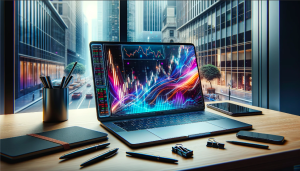Best Laptop for Stock Traders on the Go
In the volatile world of stock trading, every trader needs an efficient laptop to keep up with sudden changes. You might be unable to compete with large investment banks with headquarters as close to the stock exchange as possible for the fastest response time. However, getting equipped with the right machine will allow you to take advantage of every second you have to cash in on a shared spike.
The best trading laptops are capable enough to run the most intensive stock trading apps without lagging and portable enough to allow you to engage with the stock market from anywhere in the world. To make the job of finding the right laptop easier for you, we have compiled a list of devices suited to the needs of every stock trader. Whether you need to access color-coded technical analysis charts in real-time or just want to crunch the numbers, there is a laptop for every scenario.
What is important for a Stock Trading Laptop?
There are many factors you have to consider when choosing a laptop for stock trading. You will want a sufficiently powerful CPU so that your laptop runs smoothly. You don’t want long loading times and slow performance to distract you from focusing on trading. However, your laptop doesn’t need to have a top-of-the-line CPU to handle stock trading.
Stock traders are constantly checking news across different websites and have multiple charts open simultaneously. This means that they have a large number of browser tabs open at any given moment, which can be heavy on RAM. Most experts recommend that you have 16 GB of RAM or more so that you can open multiple tabs without compromising on performance. If you aren’t sure if your laptop has the right amount of RAM, look for one with a free RAM slot so that you can upgrade at a later date.
Similarly, if you mostly use your laptop in locations where you can’t access external monitors, it’s ideal to get a device with a high-resolution display and good viewing angles. Stock trading interfaces stuff a lot of information in very small spaces, so you don’t want to add strain to your eyes when looking at charts for longer periods.
Battery life is also a very important factor to consider when choosing a laptop for stock trading. However, this completely depends on where you mostly use the laptop. If you use your laptop primarily at home or at places where you can easily charge it, then a long battery life isn’t really important. On the other hand, if you are mostly trading on the go then battery life becomes an important consideration.
What is less important for a Stock Trading Laptop?
With all the specs we have highlighted, some are less important if your main use case is stock trading. When it comes to graphics performance, you only need a GPU that can easily power the number of external displays you want to use. Therefore, you don’t need to splurge on a pricey laptop just because it has a powerful GPU. Of course, if you want to use your laptop for gaming or other graphics-intensive applications on the side, a good graphics performance never hurts.
Another feature of a stock trading laptop that isn’t relevant is the storage since most stock trading is done online. The only thing to consider is that your laptop has an SSD drive instead of a HHD drive. An SSD will give a much faster user experience and shorter boot-up times. Since most modern laptops already come with an SSD, storage will rarely be the deciding factor between choices.
The Best Laptops for Stock Trading
Now that we have discussed what you need to focus on and what you can ignore when buying a laptop for stock trading, let’s look into the laptops themselves. We are highlighting laptops in four major categories. The best laptop overall, the best for Apple customers, the best dual-screen laptop, and the best thin and light laptop. Let’s take a deep dive into these machines.
Dell XPS 15: The Overall Champ
The Dell XPS 15 does a decent job covering all the hardware specs a good stock trading laptop needs while remaining relatively affordable. It has 32 GB of DDR5 RAM, which can easily handle the multiple windows, charts, or apps you need to use at once. This RAM is also much faster compared to the DDR4, even though RAM capacity is much more important than speed for a stock trader.
CPU performance isn’t as important as the RAM as most stock trading apps aren’t that CPU heavy. All you need is enough power to run things smoothly. In that regard, the Dell XPS 15 boasts an Intel Core i7-13700H processor. This mid-to-high-end CPU has more than enough power to handle most stock trading apps easily. It also works great for general productivity tasks, so if you want to use it for business-related activities, you will face no issues.
The other highlight is the excellent screen which is a 15.6-inch panel with a 1920×1200 resolution. The entry-level screen should be sufficient for most tasks but you also have the option to upgrade to the 3.5k OLED version. If you stick to the 1920×1200 resolution, you will be happy with the 500nits peak brightness, making this laptop ideal for bright environments. The keyboard also provides a good typing experience and the trackpad gets the job done.
M2 MacBook Air 15: The Best Option for Apple Users
If you are a MacBook user then this laptop is the best choice for you. While there is the higher-end MacBook Pro 16, we don’t think the extra inch and the greater RAM are worth the additional $1000. With the MacBook Air, you will get 16 GB which should handle all the multi-tasking you can throw at it. Similarly, the 15-inch screen is adequately large and it is a Liquid Retina display which means it has excellent color reproduction for when you end up staring at it for hours. The screen has a 2880×1864 resolution with a peak brightness of 500nits.
One of the greatest advantages of the MacBook Air is how thin and light it is at 0.44inch thickness. The touch ID sensor also helps you protect any sensitive documents that you want to store on your laptop, which is a unique feature most laptops don’t have. One thing you should consider before you spend a ton of money on a MacBook is that some trading apps aren’t compatible with MacOS. Make sure the apps you use work with the system before making the purchase.
Asus Zenbook Pro Duo 15: The Unique Dual Screen Laptop
You rarely see a dual screen that works, and the Zenbook Pro Duo is a unique option for those looking to add some excitement to their stock trading. The main screen is a 15-inch OLED display with a 3840 x 2160 resolution which makes it one of the best on the market. The smaller screen above the keyboard is a 14-inch 4k touchscreen which pops up at an angle. You can easily draw on it or use it to run additional trading apps or charts.
In the performance department, the Intel i7-12700H chip can easily handle all productivity and stock trading tasks without slowing down. The 16GB of DDR5 RAM is sufficient for most applications. And you can upgrade if you need more according to your tasks. Additionally, the machine comes with an RTX 3070 Ti GPU. Which might not be useful for stock trading but it allows you to game on this laptop as well.
Of course, there are some downsides to the unique design of the Zenbook Pro Duo. The second screen placed above the keyboard means that both the keyboard and the trackpad are somewhat crammed. Moreover, running two screens simultaneously has a significant impact on the battery life, especially if you plan to use this laptop for gaming.
LG Gram 17: The Best Thin and Portable Alternative
For some people, portability can be crucial, and the LG Gram 17 certainly offers that. At only 0.7 inches thick, it is comparable to the MacBook Air. Which is quite impressive given the specifications the Gram 17 has. Admittedly, the RTX 3050 is an entry-level card that will only allow for light gaming. But having it on hand gives versatility, especially if you also need to do things like graphic and photo editing.
It’s also relatively light at 3.2 pounds. Making it easy to transport. As long as you don’t mind the enormous 17-inch screen and wider dimensions. It operates at WQXGA resolution. And has enough of room for programs, charts, and web pages. While it’s not quite the same as having a huge 24-inch or 27-inch screen, it’s as near as you can get on a device this portable.
In terms of processing power, it has an Intel Core i7 Evo. Which is similar to other mid-to-high-end CPUs we have discussed. And is ideal for most stock-trading jobs. On the other side, you’ll be pleased to see that the LG Gram 17 has an outstanding 32GB of RAM. Which should be more than enough to have as many apps open as you like.
Final Thoughts on the Best Laptops for Stock Traders
The stock trading world is incredibly fast-paced and it is constantly changing. Any individual trader needs a laptop that can keep up with the speed of the ever-changing market. Allowing you to work in any environment. Factors like RAM and CPU performance should be at the top of your considerations list. Other specs can also be added to improve the overall package. In the end, the choice of the right laptop depends on your individual needs. We hope that this guide will help you find one that fulfills all of them.
The post Best Laptop for Stock Traders on the Go appeared first on Coinfomania.






